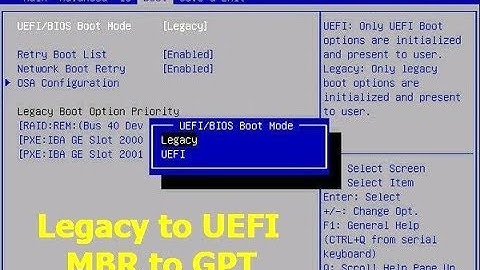determine if BIOS supports UEFI (and GPT)
Solution 1
My system allows UEFI devices, i.e. does the fact that I have the Launch EFI shell imply I have UEFI capability?
Yes; Your system is 100% compatiable with EFI based media. This is proven by the fact, you have booted to the (EFI enabled) Windows Installation Environment, while your system was configured to do so. If your system, did not support UEFI, then you wouldn't have been able to do so.
In order to install Windows on a MBR partition, you need to boot to your installation media, after you enable what is called "Compatability Mode/Legacy Mode". Once you boot to the installation media in legacy mode you will not get this error.
Currently I have an MBR disk with a legacy bios. My bios looks very similar to this one, notice the "Launch EFI Shell" which causes my confusion.
Your system is NOT using a "legacy bios" considering it has a UEFI shell. Windows considers anything that isn't UEFI mode to be BIOS. Windows 1703 has a tool that can convert MBR to GPT without data loss. This tool can be used within WinPE, I suggest you use it, and then enable UEFI only mode.
Solution 2
My system allows UEFI devices, i.e. does the fact that I have the
Launch EFI shellimply I have UEFI capability?
Yes, as does the Windows complaint about the disk using an MBR partition table -- that complaint implies that the Windows installer booted in EFI mode.
(if 1. is not just a simple
Yes) Are there any issue I may run in when utilizing the UEFI functionality?
Given your current configuration, you can't boot the existing OSes in EFI mode, since it appears they've both been installed in BIOS/CSM/legacy mode and they both seem to have BIOS-mode boot loaders.
If you wanted to boot in EFI mode, you'd need to install EFI-mode boot loaders for one or both OSes. Converting from MBR to GPT partitioning is also desirable, perhaps to the point of being necessary, especially for Windows. This blog post describes how to convert Windows from BIOS-mode to EFI-mode booting. As Ramhound says, a new Windows 10 tool can also do the job -- or so I've heard. (I've never tried this tool, so I can't promise it works, especially in a dual-boot configuration.) For Ubuntu, you'd need to install an EFI boot loader for Linux. (I describe several on this page of mine.) Because there are several options, there are several ways to do this. Two common choices are to run Boot Repair from an EFI-mode boot of an Ubuntu installation disk in its "try before installing mode" and to install my rEFInd boot manager, either from Windows or by using rEFInd on a USB flash drive or CD-R to do a one-time boot and then installing the Debian package or PPA.
Note that it's almost always best to boot all OSes installed on a computer in the same mode. Booting one in EFI mode and the other in BIOS mode is usually possible, but it's also almost always more awkward than booting both in the same mode. Thus, if you want to switch from BIOS-mode to EFI-mode booting, you should plan to switch both OSes.
Converting from BIOS-mode to EFI-mode booting poses quite a few risks. The partition table conversion itself is relatively straightforward, but if something goes wrong, it may be a struggle to recover your data. You'll probably have to resize at least one partition to make room for an ESP, and that resizing operation carries some risk. There's also the chance that installing a new boot loader will fail or create unexpected problems, so you could end up with an unbootable computer, at least until you fix the problem.
The question, then, is why you'd want to make such a change. You haven't presented much on that topic. Given the hassles and risks of converting the boot mode, you should have a pretty compelling reason to make the change before attempting it. To be sure, such reasons do exist, such as enabling access to a large (over 2TiB) disk; but more trivial reasons, such as trying a flashier boot loader, probably don't justify the risks.
Your question refers to "utilizing the UEFI functionality." For the most part, BIOS and EFI are simply ways to get the computer to boot. EFI is much more complex, and provides some minor features to the OS once it's booted, but you'll notice few differences between an OS booted in EFI mode compared to the same OS booted in BIOS mode. Your question also referred to the EFI shell. It sounds like your firmware might enable you to launch that even without the OS(es) being installed in EFI mode, but you'll find it very limiting. It resembles the old DOS prompt, but the number of EFI programs available for it is limited.
If you simply want to learn about EFI, I recommend instead using a virtualization tool such as VirtualBox or VMWare. Both provide EFI "firmware," enabling you to run an EFI shell, install an OS in EFI mode, etc. This approach is likely to be much safer than trying to convert your existing installation to boot in EFI mode or even using an EFI shell on a computer on which working OSes are installed.
Related videos on Youtube
CybeX
Updated on September 18, 2022Comments
-
CybeX over 1 year
Note: For actual question: go to the bottom
Introduction
Currently I have an MBR disk with a legacy bios. My bios looks very similar to this one, notice the "Launch EFI Shell" which causes my confusion.
Problem:
From this post, I too have
Callback_BootEnvironmentDetect: Detected boot environment: BIOSwithin the file:
C:\Windows\Panther\setupact.logMy laptop did not come with an OS (as I ordered it this way), but equivalent laptops came standard with Windows 8.
Note: The fact that it has been installed in a BIOS environment causes this
Detected boot environment: BIOSto be shown.Extra Information:
The partition scheme of the bootable medium determines which what the
BootEnvironmentwill detect, reason for this - I will explain later.Testing:
I did tests on my desktop PC which support UEFI and has CSM to check various partition schemes, etc.
I created a bootable USB with the primary OS being Ubuntu 16.10, I used Rufus for this.
MBR Partition scheme of install medium (USB Flashdrive):
- Booting with UEFI type selected fails
- Booting with Normal (MBR) selected boots successfully:
- no
/sys/firmware/efidirectory as expected, see here for more info
- no
MBR Partition scheme of install medium (USB Flashdrive):
- Booting with Normal (MBR) Fails - as expected
- Booting from UEFI selected boots successfully
-
/sys/firmware/efiis present.
-
Conclusion:
From these tests above, we can see that the initial medium's partition scheme (MBR or GPT) does not truly reflect the Host's BIOS feature.
More Information:
Creating a USB Flashdrive (as UEFI only) with Windows 10 as the OS booted successfully, however when attempting to install Windows the the HDD, an error prevented me continuing with the install. See equivalent error below.
Question:
Based on these tests above (the ability to boot a UEFI USB drive successfully), can I safely assume:
- My system allows UEFI devices, i.e. does the fact that I have the
Launch EFI shellimply I have UEFI capability?
and
- (if 1. is not just a simple
Yes) Are there any issue I may run in when utilizing the UEFI functionality?
Thanks in advance



![Windows 10 UEFI/GPT vs BIOS/MBR Bootup Time [4K UHD] (See description)](https://i.ytimg.com/vi/VV4uSU7Y_K8/hq720.jpg?sqp=-oaymwEcCNAFEJQDSFXyq4qpAw4IARUAAIhCGAFwAcABBg==&rs=AOn4CLDjR3gRzDMZqOVanQwwW_f8E43-dg)




